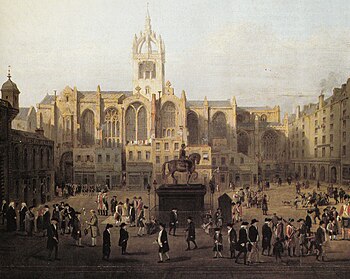Parliament Square, Edinburgh
Parliament Square,
The square also includes a statue of
History

The square came into existence in 1632 as a forecourt to the Parliament House on the old graveyard of St Giles Kirk. Parliament House not only housed the pre-union Parliament of Scotland but also the Court of Session (the supreme civil court in Scotland). This made the square a centre for the meeting of politicians and lawyers before they entered the building, from the time of its creation until the dissolution of the Scottish parliament with the Act of Union in 1707.[5]
Another building adjacent to the square was the
Henry Cockburn lamented the loss of the square's historical name, Parliament Close, a change he attributed to the silliness of fashion ("foppery") when he wrote his memoir of life in Edinburgh in the 1820s.[8]
Notes
- ^ The equestrian statue of Charles II dates from around 1685. It was the first lead statue in Edinburgh and one of the first in Great Britain (EWH staff 2012a).
References
Citations
- ^ EWH staff 2012b, p. 4.
- ^ EWH staff 2012.
- ^ EWH staff 2012a.
- ^ EWH staff 2012b, p. 3.
- ^ EWH staff 2012b, p. 1.
- ^ EWH staff 2012b, p. 2.
- ^ Anderson 1851, pp. 1, 2 (PDF).
- ^ Cockburn, H (1856), Memorials Of His Time, Edinburgh: Mercat Press reprint, p. 106
Sources
- Anderson, James (1851), "Mrs. James Guthrie, Mrs. James Durham, and Mrs. John Carstairs" (PDF), Ladies of the Covenant: Memoirs of Distinguished Scottish Female Characters
- EWH staff (2012), A sense of place, Edinburgh World Heritage, archived from the original on 1 October 2011
- EWH staff (2012a), Parliament Square, Edinburgh World Heritage, archived from the original on 2 October 2011
- EWH staff (2012b), Parliament Square (PDF), Edinburgh World Heritage, archived from the original (PDF) on 18 October 2015
